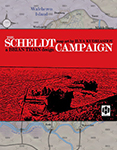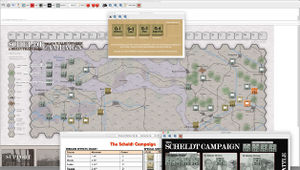Module:The Scheldt Campaign

| Publisher | Hollandspiele | Era | WWII |
|---|---|---|---|
| Year | 2016 | Topic | Western Front |
| Players | 2 to 2 | Scale | Operational |
| Length | 150 minutes |
Files
| Filename | Filetype | Size | Date | Compatibility |
|---|---|---|---|---|
| TheScheldtCampaign-21.vmod | module | 10.9 MB | 2016-10-01 | 3.2.16 |
Module Information
| Maintainer | David Janik-Jones |
|---|---|
| Contributors | Hollandspiele (publisher), Brian R. Train (designer) |
Comments
An operational level wargame of operations in the area of the Scheldt Estuary in Belgium and Holland in October and November of 1944. In late 1944, Allied advances are rapidly outstripping their ability to keep their fighting men in supply. The recently liberated port of Antwerp would alleviate this, but German coastal artillery and mines along the narrow eighty mile Scheldt River render it unusable. The First Canadian Army, which had been in continuous combat since D-Day, is tasked with clearing the Scheldt and opening Antwerp. They're opposed by the 15th German Army, whose under-strength Divisions are composed mostly of new recruits or badly-battered veterans. Confusion, limited logistical depth, and poor communications put the Germans in a desperate situation. With their backs against the wall, the Germans were defeated but fought ferociously, dealing significant casualties, with the brunt of them taken by Canadian soldiers.
The game riffs on the "Staff Card" system invented by Joseph Miranda. Each player has a hand of staff markers which he chooses non-randomly in anticipation of his next turn, and which he keeps hidden from his opponent. These drive the action and result in a sequence of play that's more fluid and less restrictive than a traditional move-combat game. Differing hand sizes for each player, as well as a different mix of markers, ably model differences in command and posture.
Small Tactical Units can be grouped together into larger Task Forces. These division-sized Task Force units enable you to move your forces quickly and efficiently to put maximum pressure on the enemy. Tactical Units have several steps of strength, with combat effectiveness gradually eroding over time, better reflecting the attritional nature of the fighting than the two-step reduction process found in other operational level games.
Aspects of bluff and tempo figure heavily into competitive play strategy, yet the game remains a viable candidate for "play both sides" solitaire study. The nature of this campaign poses challenges to the players: the grinding, attritional nature of the fighting; the difficulty of the terrain fought over; and the limited resources available to either side. The Staff Card system, adapted from Joe Miranda's "Bulge 20" system, does not allow players to move and fight every unit every turn, as is often the case in other wargames - they must choose what they want to do, and where, and how to support it. The combat system, seemingly very simple because it does not rely on odds computations or column shifts, favours the defence and reflects the incremental nature of unit losses as they wear away in the fighting.
Historical Scenario Set-Up Notes
On-map Set Up Required: The German player must place three sets of units that are on-board on the map's west edge (near the compass rose) per instructions on the German set-up sheet. After moving these units into place, click the "move" button to mark the units as un-moved.
OOB Conditions: Some Allied and German Task Forces have specific instructions for set up. Both player need to open their respective OOB windows to place additional Allied and German units per instructions in that window, and to roll for unit attrition at the start of the game. These include rolling 1d6 or 2d6 to distribute initial hits among the units in that Task Force. The German player may also start some units in hexes adjacent to the HQ unit (detached) as indicated on the OOB. The German player must also draw the required number of German scratch battalions as shown using the "Scratch" button. Complete these tasks before starting the game. Players may delete the notes (white with black text) on the specific Task Force areas after setting the game up.
Instructions
Hits: Hits are assigned to units by right-clicking on a unit and selecting "Enter # of hits (CTRL-H)" and then entering a number of hits that are applicable to that unit. Use the same method and clear the input field to remove hits. Some units on the map and OOBs have pre-assigned hits at the start of the Historical scenario.
Sides: German, Allied and Solo. Allied and German players will not be able to see the OOBs or card hands of their opponent. When playing Solo, all cards, units and OOBs are accessible to you.
German Scratch Battalions: When drawing German Scratch Battalions, right-click to draw multiple counters to drag that number off the pile. Only the German and Solo players have access to this window.
Battle: Units (*not* Task Forces/HQs) should be moved from the map or OOB to the Battle mat when combat is declared by right-clicking and selecting that option. After battle, they should be moved to the Dead Pile, back to the player's OOB, or removed from the game by right-clicking.
Version Notes v1.0 - Initial release. v2.0 - 2nd edition update
Screen Shots
Players
- David Janik-Jones
